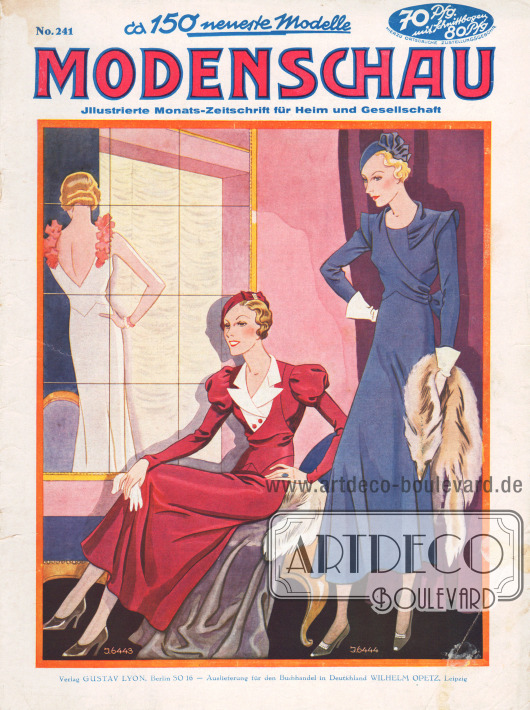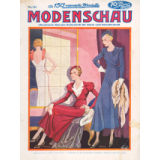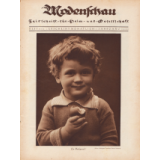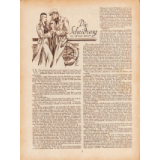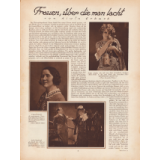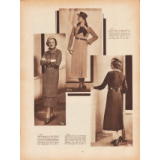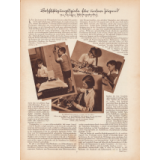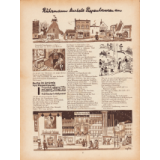|
|
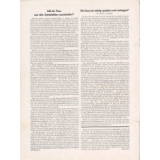
|
Article:
Baelz, Gertrud, Should Women Leave the Labor Force? (by Gertrud Baelz, author and biographical data unknown);
Torenburg, Gerda, How Do I Learn to Speak and Perform Properly? By Gerda Torenburg (biographical data unknown).
[Baelz, Gertrud, Should Women Leave the Labor Force?]
Times of hardship sometimes produce strange ideas. One of these is the suggestion that unemployment should be remedied by women leaving the workforce. Perhaps there is something initially captivating about this view when you realize that some women are now earning a living for their families while their husbands sit at home and look after the children. Of the six million unemployed, only one-fifth are women, and the young female workers usually do not make use of the facilities for the unemployed for long because they soon get a job again.
However, if we take a closer look at the professions in which women work, the picture changes. By far the largest number is represented in the occupation of farmers' wives, who, in contrast to housewives, were listed by the statistics as working, as well as their daughters and other female helpers. It is an old experience that where a farm can be managed with its own people, it thrives best. The situation is similar for many tradesmen, where the wife is simply indispensable for supervision and bookkeeping, and for sales in the store.
Can we women imagine the entire clothing trade without female tailors, milliners and embroiderers, which are among the oldest trades practiced by women? The development of trade and transportation with its modern aids has drawn many women into its sphere of influence, i.e. into working life, where they have their specially assigned fields of work, both as employees and as civil servants, in which they cannot easily be replaced by men.
In addition, there is the broad field of education, in which women have always played a major role and have had a pioneering effect on the education of girls and their further vocational training. It is impossible for men alone to be the same for adolescent girls as their female counterparts. — All of our entire social work, which is a child of the past decades, is simply unthinkable without women, who have immersed themselves in the construction of our social order and its damage and are working professionally to improve it. — Since the development of technology has meant that some craft businesses have migrated to factories, women have found their way into industry. Naturally, they have been excluded from heavy industry wherever the work primarily requires strong physical strength, but they make up a high percentage in the textile, paper, cigar, etc. trades because their special manual dexterity makes them suitable for this work, especially on the lighter machines. Thus, specialization in the labor market has assigned both men and women their own fields, which they simply cannot exchange.
And now a word about the liberal professions, which are based on certain talents and achievements, the scientist, the doctor, the artist. These women are in the service of a higher idea or of humanity, and they must not be denied the opportunity to pass on what they have drawn from themselves and turned into a valuable purpose in life.
Would it not be a misjudgement of the situation to leave these abilities of women unused in the future and return young girls to the existence of the "higher daughter" of the 19th century? The prerequisite for such a view of life was property and wealth, which later guaranteed unmarried women a secure life. Today, income is the only decisive factor; if the parents die, daughters who have had no vocational training and are therefore unable to pursue a career are left with nothing and may become a burden on public welfare. We must not deny the unmarried, of whom there will always be a large surplus of women because of the war, the opportunity to look for work in order to earn a living and to feel like a useful member of the national community.
How often does it happen that the unmarried daughter has to support her destitute parents, the widow, the divorced woman has to bring up her children. This would be inconceivable without job opportunities. Whereas the household used to exist as a production community in which women spun, wove, sewed, made pottery and prepared the provisions themselves, technology and manufacturing have gradually taken much of the work out of their hands. It is no longer possible to keep all the growing daughters gainfully employed in the household. Instead, the family has evolved into a working community in which the children also earn money.
If we draw the conclusion from what has been shown here, it can only be that it has simply become impossible for women to leave the work force as a result of our economic development. When it comes to special achievements, it is not gender but aptitude that should decide; this is a completely self-evident economic principle that makes competition possible for us women. — The lever for alleviating unemployment must be applied elsewhere, by changing our economic conditions under the auspices of a world economic agreement and a modification of our economic structure. Germany, which is suffering most from the world economic crisis, is first and foremost called upon to play a pioneering role in this. Gertrud Baelz.
[Torenburg, Gerda, How Do I Learn to Speak and Perform Properly?]
Anyone who speaks and wishes to be listened to must know under all circumstances how to make the spoken word come alive. No matter whether he is speaking in a political meeting, whether he is giving a lecture on problems of an artistic or scientific nature, whether he is explaining a cultural film, whether he is lecturing in a lecture hall or trying to make something comprehensible to an audience of children from the teacher's desk. It is important that the listener is captivated from the outset and does not get bored. It is furthermore important that the speaker detaches himself from the manuscript, because otherwise he runs the risk of slipping into a mechanical reading. Some speakers, however, never get away from the manuscript in their performance, even if they have mastered the lecture to such an extent that they speak freely; and then the spoken word almost always seems lifeless.
In posture and gesture, the speaker should be completely relaxed and unforced; any tenseness comes across as embarrassing. Of course, gesture and expression must conform to the meaning of the spoken word. In the case of the spirited speaker, facial expressions and hand gestures will always support the words, but this must not degenerate into agitational oratory. Above all, it is always important to convince through clarity and suggestive effect. You have to feel the personality of the speaker, who must know how to adapt to the intellectual level of his audience in terms of topic, delivery and expression. An opinion should never be imposed. A fine discretion always makes the speaker likeable.
The technical side of the presentation is of extraordinary and often underestimated importance. Speakers whose voices sound unpleasantly shrill or hoarse are not pleasing. And weak organs that are so unsustainable that nothing can be understood beyond the third row are a torture for the audience. If you often have to speak professionally in large rooms with poor acoustics, you should work on your vocal technique. Every voice can be trained so that it gains enough head resonance to be widely intelligible even in whispered words. Attention should also be paid to the technique of correct pronunciation. An incorrectly and obtrusively rolled rrrr can come across as unintentionally comical, and slurred final syllables do not exactly contribute to intelligibility. Dialect sounds can also be unbearable. It is also important to breathe correctly — in such a way that the breath does not run out in the middle of a sentence and the speaker suddenly has to inhale hastily at a completely unmotivated point. Breathing correctly is a great relief and gives a freer feeling. In short, if you want people to enjoy listening to you, you should try to acquire the art of a cultivated presentation, which lies in the mastery of speaking and vocal technique, in a melodious organ, in a pleasant and convincing manner of presentation. And last but not least, only those who really have something to say should speak in front of a demanding audience. — A special field today is the art of radio speaking. Here, too, the requirement is to be clear and suggestive, where all means of support such as gestures and personal appearance are dispensed with and all effect is placed solely on the word. Above all, it means simply speaking, not giving a speech with a lot of vocal effort! Don't have the idea of speaking in a huge hall to a large crowd, but speak into the microphone as if you wanted to say something into someone's ear! Insistently and personally, so that contact is established between the speaker and the invisible audience.
Although it must be admitted that a certain natural talent is a prerequisite for any kind of presentation and free speech, it cannot be denied that there is much to be systematically developed in this area.
|



